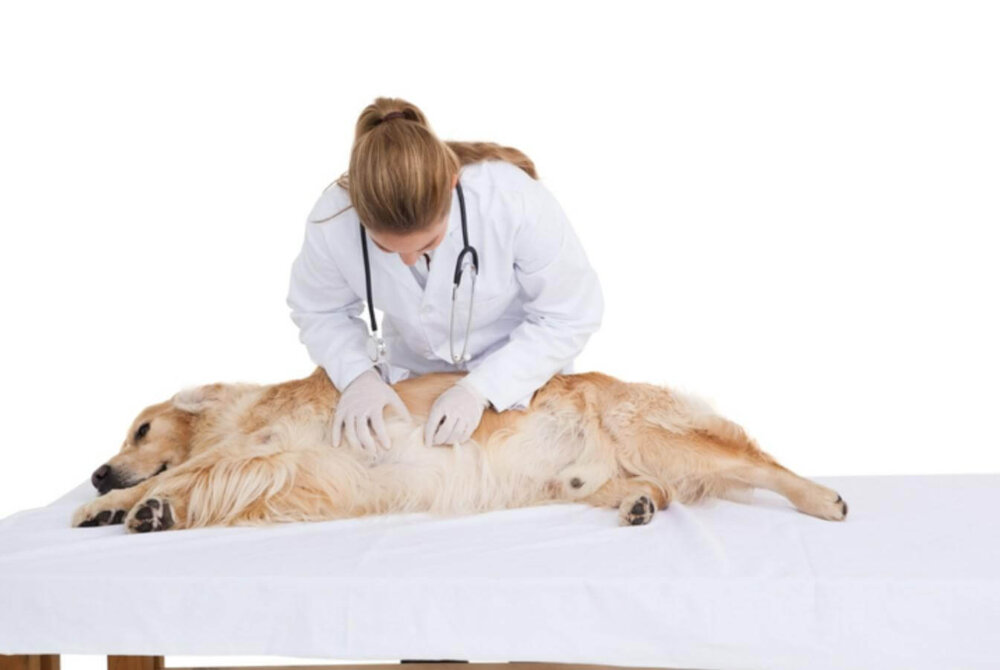7 Symptoms of Intestinal Blockage in Dogs


Written and verified by the biologist Cesar Paul Gonzalez Gonzalez
Intestinal blockage in dogs is a partial or total blockage of fluids and food in the intestine. As you can imagine, this can become fatal for dogs if not treated early and properly, so it is essential to detect the symptoms of intestinal obstruction.
The clinical signs of an intestinal blockage are quite evident when they’re acute cases, but could go unnoticed in its early stages. Therefore, the following article will list some symptoms you should be aware of in the case of a canine intestinal obstruction.
Why is intestinal blockage dangerous in dogs?
Dog’s curiosity often causes them to bite, chew, and consume different objects that attract their attention. While it’s true that most of these objects are digestible, it’s possible for some synthetic objects such as plastic or fabrics to get stuck in their intestine. As time progresses, this blockage accumulates debris and eventually interrupts the passage of food (intestinal blockage).
During this obstruction, the blood vessels surrounding the intestinal tissue are also compressed. Therefore, if this situation isn’t treated promptly, they could suffer necrosis. In addition, sharp objects can cause perforations that release intestinal contents into the peritoneum. This means that the dog will be at risk of a severe generalized infection known as septic peritonitis.
In the early stages of intestinal blockage, dogs aren’t in immediate danger. However, this condition can rapidly worsen and become life-threatening. This is why owners should be fully aware of the signs that indicate the presence of this blockage in the intestine.

Symptoms of intestinal blockage in dogs
The symptoms that indicate the presence of intestinal blockage in dogs vary depending on the location and size of the blockage. However, there are quite common clinical signs that may serve as a warning to owners. These include the following.
1. Lethargy
Lethargy is an excessive drowsiness and lack of energy in the pet. Although it may not be so obvious, intestinal obstruction causes various bodily discomforts in dogs that become stronger as they move. For this reason, they will avoid moving abruptly and may even lie down most of the time.
2. Excessive salivation
Saliva has a fundamental role during the digestive process, as it helps to pre-digest food and facilitate its transit through the intestine. Because of this, when the body detects that food takes longer than normal to leave the body, it sends an erroneous signal to secrete saliva.
3. Vomiting
Vomiting is a natural mechanism of the body that allows the expulsion of any object that would otherwise harm the individual. When there’s an intestinal blockage, the body produces vomiting reflexes in an attempt to resolve the obstruction. Of course, this isn’t always effective, but the dog’s body will keep trying and there will be frequent vomiting.
4. Loss of appetite
Intestinal blockage in dogs creates internal pressure that causes a lot of discomfort and pain. Because of this, the pet may lose its appetite or even refuse to eat. In conjunction with the other symptoms, dogs are unlikely to want to eat any food.
5. Abdominal distention
As time passes, intestinal obstruction in dogs begins to accumulate more waste that increases in size. Therefore, it causes an inflammation that can be observed and even felt. This could be more or less evident depending on the severity of the case.

6. No stools
Intestinal obstruction in dogs prevents the correct passage of food and, consequently, its exit through the stools. Because of this, one of the most obvious symptoms in dogs is the absence of feces.
7. Abdominal pain
The inflammation produced when waste accumulates in the intestine causes various organs to be pressed. Consequently, there’s a constant, stabbing pain in the area, which will only disappear when the intestinal blockage is released.
Although the above symptoms also appear in other pathologies, they should be considered as a warning sign that there’s a problem. So if you observe any of these symptoms or signs, go immediately to a veterinarian to identify the cause.
All cited sources were thoroughly reviewed by our team to ensure their quality, reliability, currency, and validity. The bibliography of this article was considered reliable and of academic or scientific accuracy.
- Hernández Moore, E., Delgado Marín, N., López Guerrero, R., & Reguero Muñoz, J. L. (2007). ¿ ES EL LETARGO UN SIGNO FRECUENTE EN LA INVAGINACIÓN INTESTINAL?. Revista Archivo Médico de Camagüey, 11(5), 0-0.
- Hernández, C. A. (2010). Emergencias gastrointestinales en perros y gatos. Revista CES Medicina Veterinaria y Zootecnia, 5(2), 69-85.
- Rascón, P. M., Rodríguez, J. M., Rodríguez, A. G., Valls, D. A., Navas, B. B., Enrica, C. B., … & Núñez, C. V. (2015). Manual clínico del perro y el gato. Elsevier.
- Rodríguez, F., García, I., & Fominaya, H. (2021). Manual de gastroenterología clínica de pequeños animales. Grupo Asís Biomedia SL.
This text is provided for informational purposes only and does not replace consultation with a professional. If in doubt, consult your specialist.